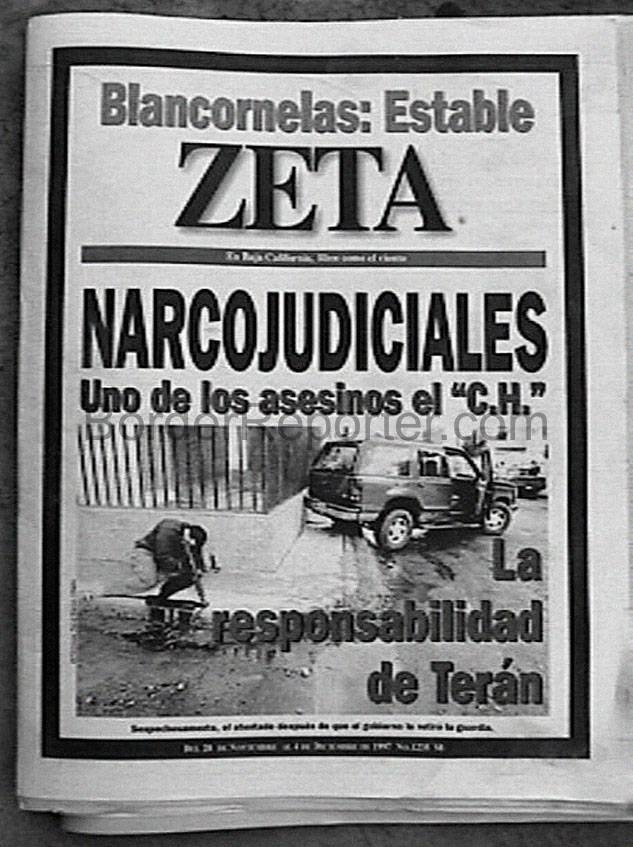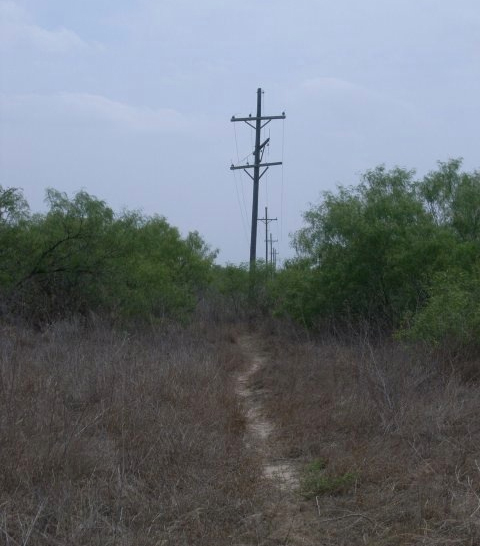THE BORDER REPORT
Pobre, pobre Mexico, con Dios en el pecho y el Diablo en los hechos. I'm still not sure whether to be pissed or laugh at this weekend's
desmadre with my (I think) former newspaper, The News of Mexico City.
The dynamic that amuses me is the same one that pisses me off, the way the old owner dismissed the staff. I don't understand what it is about the newspaper industry that, more than any other business, it seems to find the most astonishingly painful ways to fire its employees. Most businesses just fire people: "clean off your desk, you're gone, check's in the mail, here's your hat, there's the door." Newspapers seem to look for creative ways to reach the same end.
The News of Mexico City lasted less than two years under publisher Victor Hugo O'Farill who bought the English language daily in 2007 – and then quietly sold it out from under everyone last week. It's just business, some might say, and that's fine, but the man literally betrayed an entire staff, tricking them into coming in last Friday under the auspices of a special task. It was special alright, the staff was met at the door by a team of lawyers who told them two-thirds had just lost their jobs. Reporters, editors, copy-editors and even management.
This is what former Managing Editor Jonathan Clark reports happened:
"Basically, what happened was that the owner of the paper told us on Wednesday that we were moving to a new office across town – this very weekend," Clark wrote in an email to me. "Due to the move, we wouldn't publish Saturday or Sunday. But we'd have to come in on Friday anyway to help the movers label all our stuff.
"However, when we showed up on Friday, we were met by a team of lawyers who told us that we had all been fired, and that The News' parent company was dissolving. We were told that representatives from a group that had purchased The News' brand name would come later in the afternoon to speak with 14 people they had selected to be part of the next incarnation. I wasn't among the 14 and did not attend the meeting. And the previous owner also never showed up to explain in person what all had happened and why. So basically all I know is that I was fired yesterday."
Myself, I've worked for the paper since it started, writing a weekly column on all the news from up north on the border. It was (is?
quien sabe) a satisfying gig. Unlike most papers, this one's readers love the narco chismes and the inside dirt of the U.S. federal government I so enjoy writing about. If I'm ambiguous about my status with the paper, it's because I have no idea whether I still have a job or not. That remains to be decided by the new owners, Grupo Mac.
But I'm a weekly columnist, the equivalent of a part-time gig. The editors like Clark who gave that paper 60, 80 hours a week, and then were locked out of the building from one day to the next, they're the ones who deserve to be angry.
Hell, even the current employees at the paper are fired up. In an unsigned editorial this morning, the editors of The News lashed out at O'Farill, saying "When you lay off dozens of employees by surprise - as happened at The News on Friday, and as is to be expected in any merger, anywhere, particularly during an economic crisis - make a personal appearance to break the news. Have the "
cojones" to fire people yourself, thank them for their hard work and effort and face any possible backlash, rather than leaving the dirty work to the lackeys and muscle-for-hire."
Up here in Tucson, the publisher of the Tucson Citizen at least had the class to come into town and announce the paper was up for sale. Of course, the publisher, Craig Dubow, then drove to the airport in time to hop on a jet to Palm Springs to
play in the $25,000 a head Bob Hope Chrysler Classic and then turned the paper into a day-to-day operation, threatening to withhold severance packages of anyone who left before a buyer was found. But I digress. At least he showed up.
Last September, the San Diego Union-Tribune turned a buyout offer into a horse-race for its employees. The paper offered a severance package on a first-come, first-served basis that led to staff camping out in the lobby for two days. Because severance packages offer those with seniority the best deal, we were treated to the
sight of fifty and sixty year olds jostling for position at 3 in the morning.
The 1950's and 1970's versions of The News saw a newspaper horribly sunken in the politics of the PRI-istas and the CIA. We'll see what the newest News brings to the table. Hopefully Grupo Mac will be a stronger and more judicious publisher than O'Farill.
 Somebody in the U.S. government thinks that Mexico’s drug traffickers will soon turn to the sciences of the U.S. clandestine services to move their drug loads across the border.
Using remote-controlled aircraft, the narcos will smuggle loads of narcotics over the fences and walls that divide both countries. And when that gets old, the narcos will strap 750 pound barrels of dope to their chests and parachute to the ground from ultra-light aircraft, Jason Bourne-style. Some day, somebody’s going to accuse me of writing fiction and making up stories. Sadly, they would be wrong.
The scenarios come from the U.S. Army’s Asymmetric Warfare Group, a unit designed to gauge threats that was created shortly after the Sept. 11, 2001, terror attacks.
The group ran an observing mission in the San Diego and Tijuana area in early May, trying to define the methods used by the smugglers to move contraband, be it people or narcotics, across the border.
Some parts of the report, parachuting drug loads in for instance, read like the paranoid fantasies of your typical federal law enforcement agency in need of budget justifications. Others are so painfully obvious, I asked the agent who slipped the intel report to me what something like this must have cost to prepare.
Somebody in the U.S. government thinks that Mexico’s drug traffickers will soon turn to the sciences of the U.S. clandestine services to move their drug loads across the border.
Using remote-controlled aircraft, the narcos will smuggle loads of narcotics over the fences and walls that divide both countries. And when that gets old, the narcos will strap 750 pound barrels of dope to their chests and parachute to the ground from ultra-light aircraft, Jason Bourne-style. Some day, somebody’s going to accuse me of writing fiction and making up stories. Sadly, they would be wrong.
The scenarios come from the U.S. Army’s Asymmetric Warfare Group, a unit designed to gauge threats that was created shortly after the Sept. 11, 2001, terror attacks.
The group ran an observing mission in the San Diego and Tijuana area in early May, trying to define the methods used by the smugglers to move contraband, be it people or narcotics, across the border.
Some parts of the report, parachuting drug loads in for instance, read like the paranoid fantasies of your typical federal law enforcement agency in need of budget justifications. Others are so painfully obvious, I asked the agent who slipped the intel report to me what something like this must have cost to prepare.
 “Looks like the government spent a lot of money for a report about what everybody that’s ever been to the border already knows,” he said. He paused. “Should have come to me, I could’ve used the money.”
The report noted two trucks “with a distance of approximately 100 meters between the two vehicles.” Hiding in plain sight, the two trucks pointed the way to a breach in the border wall.
Graffiti taggings on one building, but none on the surrounding buildings, must also be markings for breaches in the walls, the report surmises. Engineering tape caught in the brush and fluttering in the breeze, upright water bottles on the side of the road, bright yellow bumper stickers slapped on the border wall, all with the intention of helping to move loads across.
The reality is, they’re all true. I know one U.S. Border Patrol agent who amuses herself by moving those upright bottles to spots on the highway where she can watch them more closely.
The twenty-page report is also a little disappointing to read; I have no idea why the fact that drug smugglers will conceal dope inside gas tanks is still a novel idea to U.S. law enforcement. Or why tunnels are still exciting for the Feds. But what really caught my eye is what is not in the report.
Nowhere amidst the acronym-laden jargon, the photos, the graphics, or the high-minded language do you find even a whisper of what’s still the U.S.’s most difficult challenge: corruption.
“Looks like the government spent a lot of money for a report about what everybody that’s ever been to the border already knows,” he said. He paused. “Should have come to me, I could’ve used the money.”
The report noted two trucks “with a distance of approximately 100 meters between the two vehicles.” Hiding in plain sight, the two trucks pointed the way to a breach in the border wall.
Graffiti taggings on one building, but none on the surrounding buildings, must also be markings for breaches in the walls, the report surmises. Engineering tape caught in the brush and fluttering in the breeze, upright water bottles on the side of the road, bright yellow bumper stickers slapped on the border wall, all with the intention of helping to move loads across.
The reality is, they’re all true. I know one U.S. Border Patrol agent who amuses herself by moving those upright bottles to spots on the highway where she can watch them more closely.
The twenty-page report is also a little disappointing to read; I have no idea why the fact that drug smugglers will conceal dope inside gas tanks is still a novel idea to U.S. law enforcement. Or why tunnels are still exciting for the Feds. But what really caught my eye is what is not in the report.
Nowhere amidst the acronym-laden jargon, the photos, the graphics, or the high-minded language do you find even a whisper of what’s still the U.S.’s most difficult challenge: corruption. We all know smugglers use binoculars and cellphones, great. And while it’s entertaining to learn that spotters hide in clusters of boulders because the heat the rock radiates at night foils infra-red scanners, it’s not so exciting to learn that that the driver of the tamale truck across the line is watching agents watching them.
My advice is that next time the U.S. Army visits the border, they train their binoculars a little less to the obvious goings-on to the south and a little more to the east and west. They may find a surprise or two.
We all know smugglers use binoculars and cellphones, great. And while it’s entertaining to learn that spotters hide in clusters of boulders because the heat the rock radiates at night foils infra-red scanners, it’s not so exciting to learn that that the driver of the tamale truck across the line is watching agents watching them.
My advice is that next time the U.S. Army visits the border, they train their binoculars a little less to the obvious goings-on to the south and a little more to the east and west. They may find a surprise or two. 


